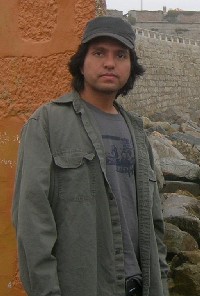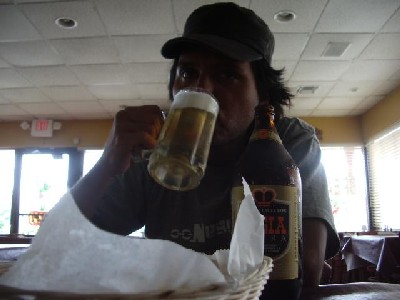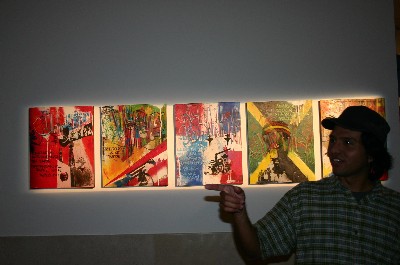
First, I must confess that I’m a bit confused with all these Miami labels: Counterflow, Botanica del Jibaro, etc. Can you tell us who’s who and what is your role on this scene?
OK. I’ll do it in time because it makes more sense. In 1997 a first electronic music label started whose name was Isoflux. Isoflux was Shad T. Scott and Seven from Chocolate Industries. Late 1997 or 1998 was the first Schematic release. In 1996, the two guys from Schematic had released a record on Astralwerks. But their second album was more experimental, and Astralwerks which is a big distributor from Carolina did not like this album, they wanted more dancefloor shit. So they started their own label. At the same time, Seven from Chocolate Industries joined Schematic and he helped them. He left them in 1998 with Edgar from Push Button Object and then both of them started Chocolate Industries. That’s basically the history of the electronic labels we have in Miami. The one thing they have in common is Seven who’s been part of all.
Meanwhile in 1996, I was in New-York and I had a t-shirt brand called Rice & Beans. But I went back to Miami and started to work as a graphic designer for lots of guy and for the promotion of this big scene. They were promoting radios and parties. So I had to do lots of flyers and things like that. I started to work at a radio station. Through that, I started go to parties and I met Seven and other guys from Schematic and Chocolate Industries. I was very enthusiastic at this time. So around 1999, we started our own label called Beta Bodega. And in 2000, I started the Rice & Beans record label. Around the same time, Merk was created and Supersoul started his own label: Metatronix. A few months later, Counterflow started and it was a hip hop label. Somewhere at that time, Chocolate Industries left Miami and moved to Chicago, Schematic continued and a new label came up that was really underground, Mass Transit, which was an electro label.
What’s the exact relationship between Counterflow, Bonica del Jibaro, Beta Bodega…?
In 1999 we launched the Beta Bodega label. But there was also a kind of coalition of labels, the Beta Bodega coalition. It’s just a group, a collective. The Beta Bodega label, Rice & Beans and Botanica del Jibaro are all parts of this coalition.
How do your recruit the artists of your labels? Is it through personal relationship or do you listen to demos?
At the beginning it was guys that I met. Local guys whose music I liked. I worked with one artist. But then this artist had a friend who had a friend. So it’s kind of personal.
And all of them are Latin-American people?
On the electronic labels about maybe half of them are Latino-American., for example the guy from Phoenicia, and Edgar from PBO is Cuban. But there are also guys from all around the world. There is one guy who is British, one guy who is German and another guy who is Jewish.
I heard about a Japanese girl as well.
Yes, in Botanica we have Killer from Japan. She is a DJ. But on hip hop labels, that’s mostly Latino Americans, and at least immigrants. There are Colombians, Haitians, Cubans and Porto Ricans.
How have you hooked up with people from other countries? For example, how have you met this Japanese girl?
I met most of them by traveling. That’s the best way to build a strong relationship. Emails are good, but sometimes you have to meet people personally. For example, David – my contact in France – was emailing me shits and I didn’t answer until I finally met him when he came to Miami. That’s the best way, we travel.
The Botanica del Jibaro releases have a strong political content. Is it a pre-requisite of your music?
Yes, the theme of the label is to have a message from the artists. At the beginning, it was difficult to have it through electronic music because there are no vocals. I would combine written things and design with the music. But now there are emcees. I chose their songs carefully. Definitely, our label has a political content. And not only with our music, but also with the design that I do. I use it to promote awareness of the problems the Latino Americans and immigrants in the US have, because that’s me as one person. I would expect other people to share their own experience, but that’s my own experience as a Latino American in the US. That will always be part of the label. And each of our artists agreed with the message we try to do.
David told me you were in France for “business’ issues?
Laughs.
Yes, we try to do that.
Now, let’s focus on your main activity as a designer. We know you design all the pictures on your records. Do you do exhibitions as well?
Yes. I started doing exhibitions in New-York and in Japan. Not a lot. I’ve done 3, 4, 5 of them… I can’t really count. But I’m busy. I have other things to do. When I don’t work for my label I have other design projects to pay my bills. And I do everything on my label, except doing music. I do the sales, design and shipping. But fortunately, I have other people who help me such as David in France and another guy in Germany. I also started a t-shirts thing. Promoting clothing is one of things we’re doing with David. There are so many things to do. We do DVDs, we do books. It’s just a start. I just try. When I launched a record label, I didn’t know how many records I would release. I just knew it was a really good way to have a message. I don’t do business; I’m not a business guy. And honestly, I hate this. But this is something I have to do to keep this going.

Can you tell us a bit more about your covers and designs and the messages you put on each record?
My main influences come from my personal experience and my Latino-American culture, and especially Ospaaal posters. It’s an organization created in Cuba as part of the revolution. They started to release magazines with posters inside. They had magazines written in Arabic, for Saudi Arabia or Palestine. And they would make posters specific to the struggles in Saudi Arabia or Palestine, for example against the princes. They had magazines for anything with leftist views. The main point is that they had a vehicle which was a magazine, and inside the magazine they had that poster. I have the same ideal: getting a message through something else, through another media. In those magazines, the poster was the message. If you study these posters, you’ll see they were very bold and to the point, very graphic, because of the style of these Cubans. But as I grew up in New-York City with graffiti, where walls were a mess, my mind is a lot more complicated, more disorganized. So when I started doing design, it was not so simple, not as simple as a letter or a text. I had to do more intricate things. That’s not my style to do something bold and simple. I like to be more abstract. But I hope that the people will look at the artwork and get the message or the general idea. That’s why we include text also. But the text does not have to be necessarily linked to my artwork. You have three different levels: you have music, you have text, and then you have my artwork, and they don’t necessarily relate. Sometimes, there are things you don’t care. Maybe you just like the music, or maybe you just like the design. But as long as you bring this shit in your house, you can discover the later the message on the record. Or maybe someone else will discover your record and understand the message. As long as the thing exists and it gets somewhere, that’s important. This is my view. That’s just my way to send a message. I just do what I do.
Are you a musician as well?
I love music. I love music so much that I know I have no musical talent. I respect music so much. A lot of record label are owned by musicians. And I think this is the reason why they go down. This is because they’re part of their own things. They take things personal and tell things such as “my music is better than yours” or “I don’t like this artist”. I listen to lots of things, I like to experiment noise shits and when I find it good, I put it up. I’ll never say “I’m a hip hop guy, and then I can’t deal with electronic shit”, or “I’m in electronic, I don’t like hip hop”. In the US, people are very closed about things.
In France as well.
That’s the US that interest me.
Laughs.
In France, I have the feeling hip hop fans are more separated from pop / rock fans than in the US. I have the feeling American fans can more easily listen to each kind of music.
I would agree with that because pop means a lot of things. It can be pop rock, pop dance and lots of things. And rock is the fundamental American music. It’s just in our blood as Americans. But in Miami, that’s not in the blood. When immigrants came from Cuba they brought Latin music. And in Miami, all the Anglo Americans, the White Americans, left. They escaped Miami to get away from all the Cubans and Black people. So in Miami, rhythm is in everything such as dance, bass, electro. When techno came to Miami, it really affected people. They understood it. When you listen to electro, you have the same things as in Black or Cuban music. So there’s never been a rock scene. When a rock band comes to Florida, it tours everywhere, but never in Miami. They have to find white people.
Miami has a specificity. In this city, the electronic and hip hop scenes are very close. I guess it’s not the case in the rest of the US.
Yes, really. Most of the guys such as Seven and thee guys from Schematic are pioneers. They were ahead of their time. But this is not a huge scene. There’s just like ten people that do shit. The rest of Miami is so commercial, so in parties. They’re not underground.

I have friends who are more fans of alternative rock or indie pop. And some of them enjoy the hip hop coming from Miami. That’s very strange because this music is very far from them. And you had the same kind of rapprochement when Seth P. Brundel’s Devil’s Pawn album was released on Aesthetics, a label more focused on rock things, and sometimes soft pop such as L’Altra.
Yes, the owner of Aesthetics is really a big fan of hip hop. He did not hear my records but Counterflow records and contacted Seth P. Brundel. I don’t know if it is because of mood, or lyrics, whatever it is. We’ll never know.
Let’s get back to your design activity. You did the cover art of Raekwon’s The Vatican mixtape. How have you connected with him?
I’m a Raekwon fan, I’m Wu-Tang Clan fan, but I’m not connected with him. The label gave me the opportunity to do it. They’ve heard about me through Counterflow Records. In Miami, I’m known as the guy who’s in design, the guy who does nice shit and pretty shit.
What do you plan to release in the forthcoming months?
You know, there are no more Beta Bodega and Rice & Beans labels. Arepaz and Botanica del Jibaro are the only labels that still exist. With Botanica, we have a CD/DVD with the Botanica All-Stars. When we went to Portugal last year, we did this thing. This is 6 members of Botanica, I did visuals in extension of their show. As far as albums are concerned, we have a Seven Stars project, but we don’t know exactly when we’ll release the CD. We have Leadership Midnight from Soarse Spoken that is already out in Japan. We hope to release it in Europe and the rest of the World. We have a lot of things, but we are in the process of finding distributors. That’s one of the reasons I’m here. But those projects are definitely ready.
Are you optimistic about improving distribution?
It’s so difficult. It’s the worst part. Business, that’s the worst shit. If you analyze this as a business guy, you see how much you cost and how much you sell. The business doesn’t make any sense. Making vinyl is not a business, making a CD I guess is a business as far as you’re looking at profits and all the other shits. It’s just hard, it’s difficult. Optimistic? I guess I’ve never been optimistic. When I started my first Beta Bodega record, I thought this would be the last one. It was all experiment. Every record that we do is an experiment. So, we’ll see. In Japan we have a very good system going on. In US we have to get things done. It’s just cycles. Theirs is a point where a label comes out and everybody is very interested. And when they start to lose interest, then there is another group emerging. That’s why lots of label quit.
Just before we start this interview, you told me you had a concert in Germany a few days ago. Was it with someone else from your label?
No, this was just a DJ gig. A guy we work with in Germany put it together in Dresden, the guy from the Mooncircle Project.
Well, you’re in France right now. What do you know of the French hip hop and electronic in scene?
The first time I came in France people told me that there was a kind of rivalry between groups in Marseille and groups in Paris. This is usual in hip hop.
Yes, they just try to imitate the competition between the East and West Coasts.
Yes.
Laughs.
That’s hip hop. Hip hop is egos. That’s universal.
Any final message to French people?
A message? Kill your president.
Laughs.
That’s a good idea.
Yes. Politics, governments, that’s all so bullshit. Well, I think that French people have better grip on reality than Americans. They can go straight and protest and do things like that. In the US, you just have two places on the East and West Coast like this, that’s New York and San Francisco. Everywhere else, nothing can happen. They just care about being home, watching TV…
People are more and more like that in France as well.
Yeah? In the US, people are acting within their own communities. Americans like to be in suburbs and build communities. America is all about getting away. That’s just the way it is. You always have to understand that Americans were immigrants, people with no roots. They destroyed entire peoples, stealing lands, bringing slaves. So my message to French people would be: stay French.
NDLR : Thanks to David from D7sign.







